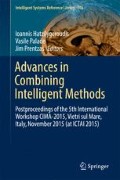Abstract
Feature maximization is an alternative measure, as compared to usual distributional measures relying on entropy or on Chi-square metric or vector-based measures, like Euclidean distance or correlation distance. One of the key advantages of this measure taking inspiration both from Galois lattice theory and information retrieval is that it is operational in an incremental mode on traditional classification. In this framework, it does not have the limitations of the aforementioned measures in the case of the processing of highly unbalanced, heterogeneous and highly multidimensional data. We present a new cross-domain application of this measure in the clustering context for setting up new cluster quality indexes that are tolerant to noise and whose efficiency ranges from low to high dimensional data.
Access this chapter
Tax calculation will be finalised at checkout
Purchases are for personal use only
Notes
- 1.
Using p-value highlighting the significance of a feature for a cluster by comparing its contrast to unity contrast would be a potential alternative to the proposed approach. However, this method would introduce unexpected Gaussian smoothing in the process.
- 2.
As regards the principle of the method, this type of selected features inevitably have a contrast greater than 1 in some other cluster(s) (see Eq. 6.3 for details).
- 3.
References
Angel Latha Mary, S., Sivagami, A.N., Usha Rani, M.: Cluster validity measures dynamic clustering algorithms. ARPN J. Eng. Appl. Sci. 10(9) (2015)
Arellano-Verdejo, J., Guzmn-Arenas, A., Godoy-Calderon, S., Barrn Fernãndez, R.: Efficiently finding the optimum number of clusters in a dataset with a new hybrid cellular evolutionary algorithm. Computacin y Sistemas, 18(2):313–327 (2014)
Bache, K., Lichman, M.: UCI Machine learning repository. University of California, School of Information and Computer Science, Irvine, CA, USA (2013). http://archive.ics.uci.edu/ml
Bock H-H (1996) Probability model and hypothese testing in partitionning cluster analysis. In: Arabie P, Hubert LJ, De Soete G (eds) Clustering and Classification. World Scientific, Singapore, pp 377–453
Calinsky T, Harabasz J (1974) A dendrite method for cluster analysis. Commun. Stat. 3(1):1–27
Davies, D.L., Bouldin, D.W.: A cluster separation measure. IEEE Trans. Pattern Anal. Mach. Intell. PAMI-1, 2:224–227 (1979)
Dimitriadou E, Dolnicar S, Weingessel A (2002) An examination of indexes for determining the number of clusters in binary data sets. Psychometrika 67(1):137–159
Dunn J (1974) Well separated clusters and optimal fuzzy partitions. J. Cybern. 4:95–104
Falk I, Lamirel J-C, Gardent C (2012) Classifying French Verbs Using French and English Lexical Resources. Proccedings of ACL, Jeju Island, Korea
Fritzke, B.: A growing neural gas network learns topologies. In: Tesauro, G., Touretzky, D.S., Leen, T.K. (eds.) Advances in Neural Information Processing Systems 7, pp. 625–632 (1995)
Guerra L, Robles V, Bielza C, Larrañaga P (2012) A comparison of clustering quality indices using outliers and noise. Intell. Data Anal. 16:703–715
Gordon, A.D.: External validation in cluster analysis. Bull. Int. Stat. Inst. 51(2), 353–356 (1997). (Response to comments. Bull. Int. Stat. Inst. 51(3), 414–415 (1998))
Halkidi M, Batistakis Y, Vazirgiannis M (2001) On clustering validation techniques. J. Intell. Inf. Syst. 17(2/3):147–155
Hamerly, G., Elkan, C.: Learning the K in K-Means. In: Neural Information Processing Systems (2003)
Kassab, R., Lamirel, J.-C.: Feature based cluster validation for high dimensional data. In: IASTED International Conference on Artificial Intelligence and Applications (AIA), pp. 97–103. Innsbruck, Austria, (February 2008)
Kolesnikov A, Trichina E, Kauranne T (2015) Estimating the number of clusters in a numerical data set via quantization error modeling. Pattern Recognit. 48(3):941–952
Lago-Fernãndez LF, Corbacho F (2009) Using the negentropy increment to determine the number of clusters. In: Cabestany J, Sandoval F, Prieto A, Corchado JM (eds) Bio-Inspired Systems: Computational and Ambient Intelligence. Springer, Berlin, pp 448–455
Lamirel, J.-C., Francois, C., Shehabi Al, S., Hoffmann, M.: New classification quality estimators for analysis of documentary information: application to patent analysis and web mapping. Scientometrics 60(3), 445–462 (2004)
Lamirel, J.-C., Mall, R., Cuxac, P., Safi, G.: Variations to incremental growing neural gas algorithm based on label maximization. in: Proceedings of IJCNN 2011, p. 956–965. San Jose, CA, USA (2011)
Lamirel J-C (2012) A new approach for automatizing the analysis of research topics dynamics: application to optoelectronics research. Scientometrics 93(1):151–166
Lamirel J-C, Cuxac P, Chivukula AS, Hajlaoui K (2014) Optimizing text classification through efficient feature selection based on quality metric. J. Intell. Inf. Syst. 2013:1–18 Special issue on PAKDD-QIMIE
MacQueen, J.B.: Some methods for classification and analysis of multivariate observations. In: Proceedings of 5th Berkeley Symposium on Mathematical Statistics and Probability (1), pp. 281–297. University of California Press (1967)
Milligan GW, Cooper MC (1985) An examination of procedures for determining the number of clusters in a dataset. Psychometrika 50(2):159–179
Rendón E, Abundez I, Arizmendi A, Quiroz EM (2011) Internal versus External cluster validation indexes. Int. J. Comput. Commun. 5(1):27–34
Rousseeuw PJ (1987) Silhouettes: a graphical aid to the interpretation and validation of cluster analysis. J. Comput. Appl. Math. 20:53–65
Sun, L., Korhonen, A., Poibeau, T., Messiant, C.: Investigating the cross-linguistic potential of VerbNet-style classification. In: Proceedings of ACL, pp. 1056–1064. Beijing, China (2010)
Yanchi, L., Zhongmou, L., Xiong, H., Gao, X., Wu, J.: Understanding of internal clustering validation measures. In: Proceedings of the 2010 IEEE International Conference on Data Mining, ICDM’10, pp. 911–916 (2010)
Xie, X.L., Beni, G.: A validity measure for fuzzy clustering. IEEE Trans. Pattern Anal. Mach. Intell. 13(8), 841–847 (1991)
Author information
Authors and Affiliations
Corresponding author
Editor information
Editors and Affiliations
Rights and permissions
Copyright information
© 2017 Springer International Publishing Switzerland
About this chapter
Cite this chapter
Lamirel, JC. (2017). New Quality Indexes for Optimal Clustering Model Identification Based on Cross-Domain Approach. In: Hatzilygeroudis, I., Palade, V., Prentzas, J. (eds) Advances in Combining Intelligent Methods. Intelligent Systems Reference Library, vol 116 . Springer, Cham. https://doi.org/10.1007/978-3-319-46200-4_6
Download citation
DOI: https://doi.org/10.1007/978-3-319-46200-4_6
Published:
Publisher Name: Springer, Cham
Print ISBN: 978-3-319-46199-1
Online ISBN: 978-3-319-46200-4
eBook Packages: EngineeringEngineering (R0)

